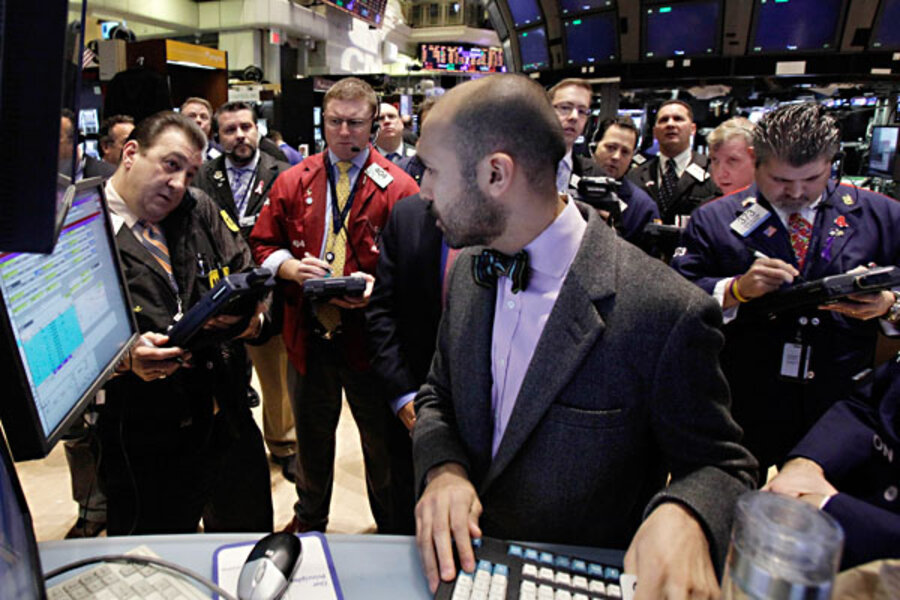Strong housing report boosts stocks
| New York
A surprisingly strong report on the housing market and the prospect of more cash for the International Monetary Fund to fight off a financial crisis powered stocks Wednesday to their highest close since last summer.
The Standard & Poor's 500 index closed above 1,300 for the first time since July 28, and the Dow Jones industrial average finished at its highest since July 25. That was just before the bitter fight in Washington over the federal debt limit.
It was also the first time since Jan. 3, the first trading day of the year, that the S&P 500 moved more than 1 percent. The market has made a quiet ascent since then. The S&P is up 4 percent for the year, the Dow 3 percent.
"We think things are setting up to be better than last year," said Brad Sorensen, director of market research at Charles Schwab. "The worst-case scenario is off the table."
The National Association of Home Builders index, a measure of sentiment among builders, rose to its highest level since June 2007 as sales jumped. Analysts said it could be a sign the housing market has bottomed out.
The index is rising because builders are seeing a rise in people shopping for a home, not because they are seeing more sales, at least not yet. Those in a position to buy are benefiting from lower prices and mortgage rates.
Stocks of home construction companies jumped. PulteGroup Inc. rose 6 percent, Toll Brothers Inc. rose 5 percent, and KB Home rose 8 percent.
In another encouraging sign, the Federal Reserve said manufacturing rose 0.9 percent from November to December, the biggest gain since December 2010.
Christine Lagarde, managing director of the IMF, said the fund wanted to raise $500 billion more to lend to countries. The IMF has put up roughly a third of the rescue loans to debt-hobbled European countries over the past two years.
Investors are eager for signs that the world can contain Europe's debt problem. Besides an already likely recession in Europe, a messy default by Greece or another country could lead to a financial crisis around the globe.
In other trading, Goldman Sachs stock added almost 7 percent after its quarterly profit beat Wall Street expectations. Net income still fell 58 percent in the last three months of 2011, a result of choppy financial markets.
Some bank stocks followed Goldman higher. Morgan Stanley, another investment bank, rose 6.8 percent. Bank of America rose 4.9 percent, JPMorgan Chase 4.7 percent and Citigroup 2.9 percent.
Other financial stocks sank after disappointing earnings reports. State Street Corp. plunged 6.6 percent, the largest fall in the S&P 500. PNC Financial Services Group Inc. fell 2.6 percent, and Northern Trust Corp. slipped 2 percent.
The Dow finished up 96.88, or 0.8 percent, at 12,578.95. The S&P rose 14.37, or 1.1 percent, to 1,308.04. The Nasdaq composite index, which has outperformed the other two this year, rose 41.63 points, or 1.5 percent, to 2,769.71.
Among other stocks making large moves Wednesday:
— Yahoo climbed 3 percent on news that co-founder Jerry Yang is leaving the struggling Internet pioneer. The departure clears the way for newly hired CEO Scott Thompson to take more radical action to shake up the company.
— Amphenol Corp., which makes fiber-optic cables, soared 11 percent. Its earnings that beat analysts' expectations, and the company said strong orders should push next year's earnings above Wall Street forecasts.
— Linear Technology Corp., which makes circuits, jumped 11 percent, most in the S&P 500. It expects quarterly revenue to rise 4 to 8 percent following strong demand in December and January. It also raised its dividend by a penny to 25 cents a share.
— Cash America International Inc., a payday lender and operator of pawnshops, sank 6 percent after cutting its earnings forecast.






